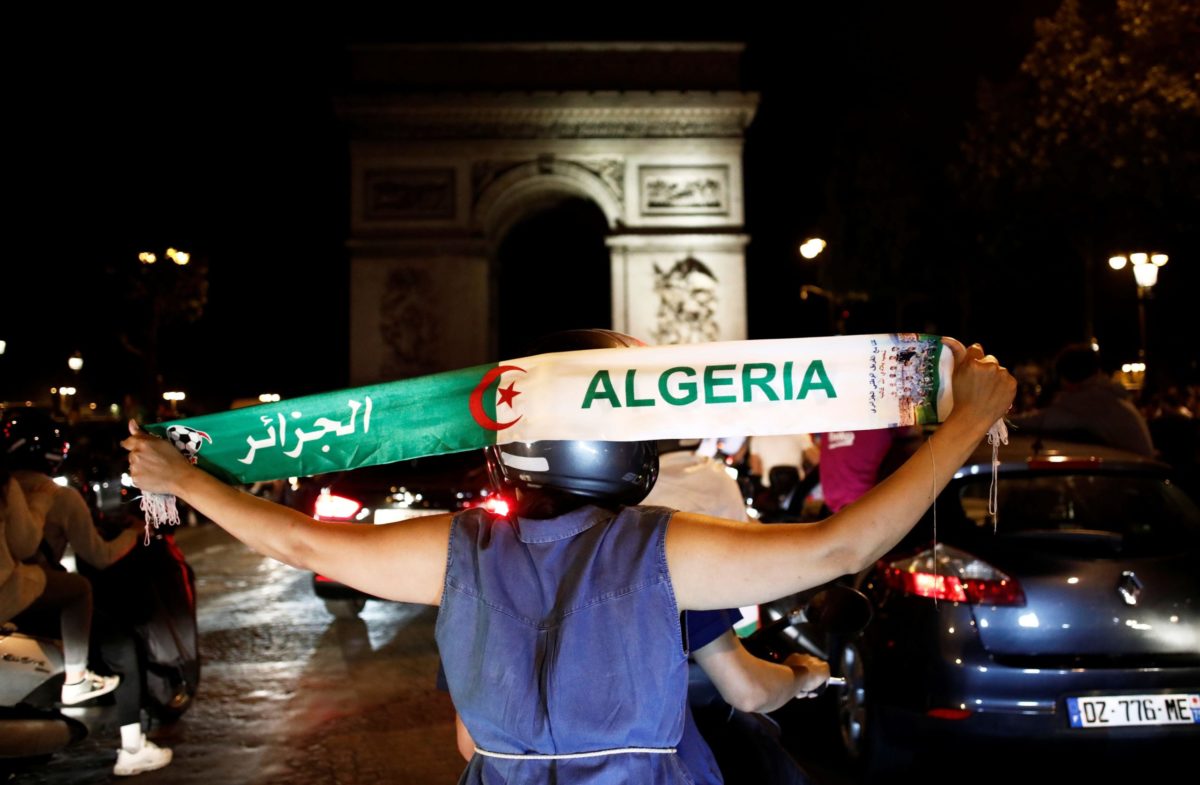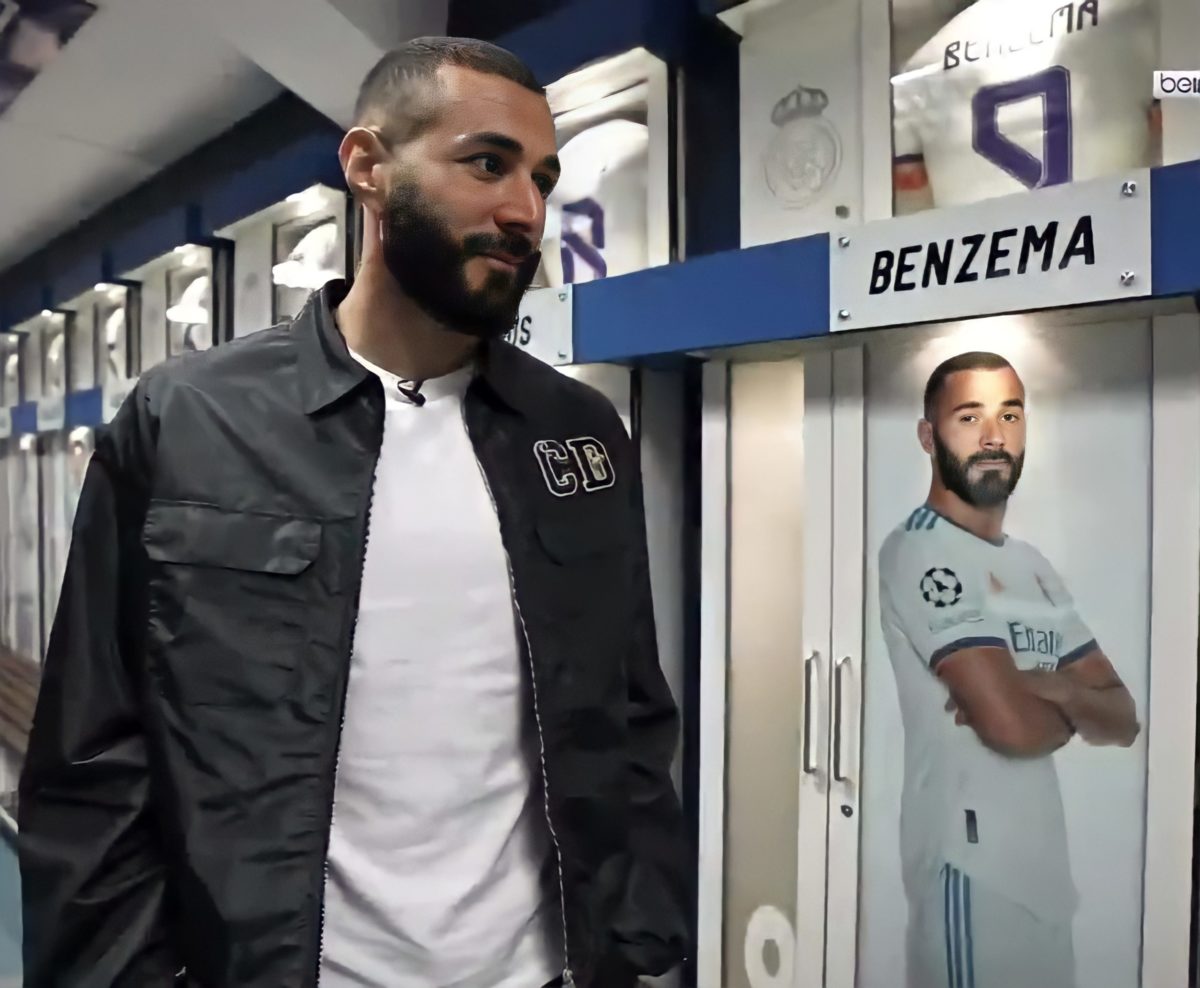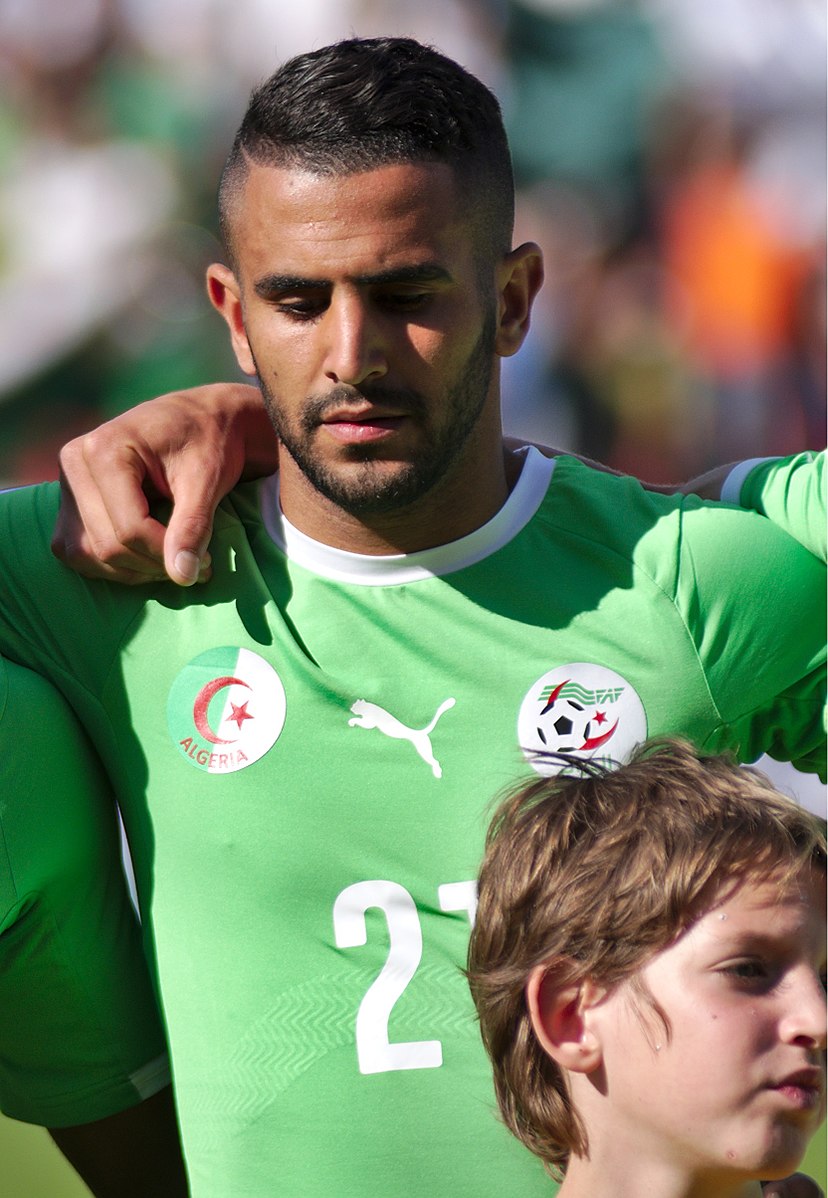
Football fans in Paris, France celebrate Algeria’s victory in the 2019 Africa Cup of Nations on July 19, 2019. Benoit Tessier/Reuters
The same might be said of football as it has been taken up in Algeria and by Algerians in France. Algeria won independence from France in 1962, but legacies of colonialism and decolonization have long shaped, and continue to influence, what football means to the large shared population of binational citizens between these two places. One in every ten people in France has a direct familial connection to Algeria, complicating any distinction of national belonging and clouding footballing loyalties. Fans decide which national side to back, or opt to support both, in international tournaments. In the case of professional footballers, they must choose which nation to play for.
Riyad Mahrez, the current captain of the Algerian national team, is also a winger for the British club Manchester City. Mahrez was born to working-class Algerian parents in the diverse Parisian periphery town of Sarcelles, now home to a stadium named after him that hosts one of the Coupe d’Afrique des nations locale. These competitions are local spin-offs of the Africa Cup of Nations, in which non-professional footballers residing in France represent their countries of origin.
Mahrez’s choice to play for Algeria contrasts with that of Karim Benzema, a star striker for Real Madrid, who grew up outside of Lyon also to working-class Algerian parents, and who recently won the most coveted prize for the world’s greatest players, the Ballon d’Or, which he dedicated to “le peuple” (the people), recalling perhaps the most powerful symbol in Algerian politics: ash-sh’ab. The professional careers of these two players reflect the broader and longer entanglements between France and Algeria when it comes to the sport of football. They also point to the increasingly central role of global capital, particularly from the Gulf, in setting the terms for the French and Algerian sporting scenes.
The Rise of the “Association” in Colonial Algeria
At the turn of the twentieth century, French lawyer, sports activist and Christian Democrat, Jules Rimet, was at the helm of the mission to “civilize” the world through sport. In 1904 Rimet founded the Federation Internationale de Football Association (FIFA) in Paris and later went on to help organize the first World Cup. The creation of FIFA occurred in parallel to, and was no doubt impacted by, the process of secularization in France. The laïcité law, which subordinated church to state, was established just one year after FIFA. It drew on the earlier 1901 Law of Associations, which suppressed most religious orders, establishing the legal basis for civic organizations called “associations.” Perhaps the backbone of French and, at the time, imperial civic life, associations remain the key institutional structure for the organization of sporting and leisure activities in France today. There are currently more than 1.5 million associations in the country, representing a staggering three percent of France’s GDP.
In both the colonial periphery and the metropole, football served to link French ideologies of secular universalism with imperialist expectations of social cohesion and mobility through cultural assimilation. Rimet’s early-twentieth-century views on sport and social cohesion underscored the beliefs of the time in a supposedly seamless progression from colonization to immigration to assimilation. Such views were bolstered by increasing class mobility in colonial France. Rimet, himself, was the son of a farmer. Before founding FIFA, he had initiated France’s first working man’s football club, Red Star, in 1897. Through Red Star, Rimet sought to realize his ideals regarding the emancipation of the working classes and improve French social cohesion through sports. From the 1920s onwards, he sought to further this project by making football a “means of understanding and friendship among peoples.”[1] A clear racial superiority underpinned this philosophy, and the subsequent years would see the imposition of a discourse on the civilizing value of sport upon indigenous subjects of the French Empire wishing to play.
As football clubs grew more widespread in France in the 1920s, the universalist ethos underwriting French associations came to affect sporting and cultural life in French Algeria, particularly in the heavily populated urban capitals of Algiers and Oran. The secular universalist ideals of football and other civic organizations stood in tension with an incipient North African nahda (renaissance) and its anti-colonial politics, which built on and connected to wider late Ottoman and emergent Arab nationalist projects. Algerois Jews, too, began to feel the influence of transnational Jewish associational life in the 1920s, particularly through the Istanbul Maccabi sports club network—part of a broader international Jewish sports organization founded by Jewish athletes who had been refused membership from other social sport clubs.
Notwithstanding these local and transnational links, young Algerian footballers found themselves on the front line of French psychological indoctrination. Associations were a site of language inculcation, and French was the medium with which to express and assimilate secular and universalist values. Beyond football, the new national pastime of cinema served as a vehicle for the promotion of the French language, and the Muslim Boy Scout movement modeled itself after the éclaireurs (French scouts), maintaining elements of imperial French civic education.
Unlike local Algerian Jews, Muslims were excluded from political citizenship and denied rights of free speech and assembly, including the right to create associations. Nonetheless, many local Algerian Muslim dignitaries and sports enthusiasts pushed back against the exclusion of “indigenous” Algerians from French republican freedoms and formed their own sporting clubs. They often used the designation club musulman or union sportive musulmane.[2] Mouloudia Club d’Alger (MCA) was the first of these clubs to form, in 1921. It was a multi-sport club and situated itself, not in a universalist secularism tied to French linguistic and cultural assimilation, but rather a universalist Islamic ethics associated with a burgeoning clerical (‘ulama) movement.
Algerian Footballers between France and the FLN
As the Algerian indigenous football scene grew, so too did the economic migration of Algerian footballers to France. Before independence, Algeria was legally part of France and Algerians were granted freedom of circulation between France and Algeria. From the 1940s onward Algerian footballers went to France alongside, but in greater numbers than, their Moroccan, Tunisian and Senegalese counterparts.
The youth of Algiers looked up to players like Moustapha Zitouni, who transferred to AS Monaco in 1954, and Rachid Mekhloufi, who transferred to Saint-Etienne the same year. These players had traversed the Mediterranean, first leaving “Muslim” clubs for wealthier and more famous “European” ones in Algeria, and then moving to metropolitan France. By playing first for European clubs in Algeria and then French clubs, footballers adapted to a French lifestyle, achieved social mobility and often internalized meritocratic sporting values. Their influence upon youths back in Algeria was one way that the soft power of French imperialist ideology permeated the relationship between European and indigenous football in Algeria.
The tangible prize of economic advancement ensured that many talented Muslim players ended up in France or were drafted into the larger, wealthier European clubs in Algeria. Often less politicized upon departure for France, these players, after finding recognition for their sporting talent in France, also came to realize the degree of racial discrimination in colonial Algeria.[3]
France pushed back against these symbolic matches, vetoing FIFA recognition of the FLN team and even threatening economic sanctions against nations that hosted the FLN in matches.[5] Such gestures met with little success. It was growing increasingly clear that Algeria would achieve independence and that France would eventually have to play against the newly established Algerian nation-state. The Algerian anti-colonial movement was retooling French universalist ideas of sport to assert national sovereignty. Organizing their own indigenous Algerian civic associations through sports—whether the FLN team of 1958 or the Mouloudia Club d’Alger of 1921—was a step towards self-determination. With this historical context in mind, it is perhaps of little wonder that history sits heavy on the shoulders of players like Mahrez and Benzema, whose familial trajectories are rooted in a past of conflict and subversion.
Football and the Banlieue
The social and affective ties between France and Algeria were not severed by the war of independence. If anything, the initial decades after independence brought the destinies of Algeria and France even closer. Between 1963 and the late 1970s—when the president Valérie Giscard d’Estaing put a stop to family unification policies—France remained the most popular destination for Algerian immigration.
Algerians were often concentrated in the French urban peripheries and shantytowns, where suburban (banlieue) housing projects were built adjacent to the factories in which Maghrebi immigrants worked. The banlieue would produce many of France’s greatest football stars, including Benzema and Mahrez, the latter of whose parents moved to Sarcelles in the 1970s.
The Maghrebi (and particularly Algerian) presence has had a decisive influence on postcolonial France and the evolution of its national project and politics. French anxieties around immigration, security, national identity and social cohesion, tend to focus on the banlieue. Events like the 2005 Clichy-sous-Bois youth mobilizations against police brutality, following the deaths of two French teenagers of immigrant descent who were running from the police on the way home from a neighborhood football match, have been accompanied by a shift in the French political scene to the right. The perpetual concern for urban and national “security” in the form of policing the peripherical banlieue intensified further in the wake of the 2015 Charlie Hebdo and Bataclan attacks.
At the heart of this impressive machinery for the promotion of footballing excellence is the National Centre for Football in Clairefontaine. Benzema and Mahrez, who came from the banlieue, are both products of the Clairefontaine academy system. On the one hand, the Centre serves as a testimony to the deepening relationship between science and sport, with its embracing of psychological methodologies and statistical technologies. On the other, the academy system has replaced France’s colonial organization of footballing with the postcolonial management of generations of French-born footballers whose parents or grandparents came from the colonies. Clairefontaine and the French Federation, which recruit heavily from the banlieue, draw on the language of “social cohesion” to discipline players. For example, Patrice Evra, the Senegalese-born fullback and France’s team captain at the start of the 2010 World Cup, led the players in a boycott of what he saw as institutional racism on the team following the dismissal of a teammate. The French Federation’s response was to bench Evra during the tournament, blaming the player for undermining France’s national unity.[7]
Transnational Capital Enters the Game
Over the last several decades, three French professional football clubs have dominated the domestic scene and transformed sport’s “civilizing mission” into an investment instrument of global capital. Significant financial clout first came to the French game via Olympique de Marseille (OM), particularly under the directorship of business tycoon Bernard Tapie between 1986-1993. The club notably won its very first Champions League final in 1991-1992 then subsequently found itself at the center of multiple corruption scandals concerning match-rigging and the bribery of referees.
These scandals allowed Olympique Lyonnais (OL) to rise to the top of French football under the watchful eye of director Jean-Michel Aulas between 1987-2009. While Olympique de Marseille had put its youth academy to the side during the club’s downturn, Olympique Lyonnais shrewdly invested locally, particularly in players from socio-economically disadvantaged banlieues such as Bron-Terraillon, where Benzema grew up.

Karim Benzema, during an interview in 2021. Real Madrid Youtube Channel, CC 3.0.
The third of these clubs is Paris Saint-Germain, which was founded in 1970, and since 2011 has become a domestic and global powerhouse with a massive investment in players’ salaries and transfer fees. The club is owned by Nasser Al-Khelaifi via Qatar Sports Investments group (QSI), a national sovereign wealth fund that is also behind the 2022 Qatar World Cup. Al-Khelaifi is the chairman of beIN Media Group, one of the world’s largest sports broadcasters with a global reach in multiple languages across France, Spain, Turkey, North Africa and the Middle East in addition to partnerships with British and US-American studios and media groups.
The transnational business interests in sports media and merchandising (Tapie chaired Adidas from 1990 to 1993) have brought French football onto the international scene. Beyond the sporting success of individual domestic clubs, France has become a leading exporter of seemingly endless footballing talent, propelling particular individuals from some of France’s poorest peri-urban towns—such as Sarcelles or Bron-Terraillon, in which Mahrez and Benzema grew up—to super stardom at the greatest European clubs.
The footballing trajectories of these two players reflect how the legacies of French colonial ideology and investments, which sought in previous times to bind indigenous Algerian football players to France, are being replaced by increasingly nebulous transnational capital. Manchester City, the club Mahrez plays for, is owned by Abu Dhabi’s sovereign wealth fund. The team has become a global brand and Mahrez himself a key part of their investment strategy.
Entangled Presents
Branding stretches beyond club and country into the international arena. Despite playing for two different national teams, Algeria and France, Mahrez and Benzema are connected through the multibillion-dollar global World Cup tournament—a tournament that throws into relief the complex space occupied by French-Algerian footballers.
The period between France’s close loss in the 2006 World Cup finals in Germany—made famous by Zinedine Zidane’s head butt—and their 2018 victory at the World Cup in Russia was portrayed as one of relative crisis for French national football. When Les Bleus under-performed in South Africa and Brazil, players were blamed for putting their personal and political identities above their subservience to the greater national good. They were criticized for fasting during Ramadan, or, as in the case of Patrice Evra, for publicly accusing the French Football Federation of institutional racism. It was at this time too that Benzema became the object of far-right scorn.

Riyad Mahrez at a friendly match between Algeria and Armenia in May 2014. CC 3.0.
The same period coincided with Algeria’s sensational foray into the FIFA top 20. They lost narrowly to Germany in the second round of the 2014 World Cup tournament—the first time in Algeria’s history the team had made it past the group stage. The Algerian team strongly identifies as Muslim and projects this identity on the pitch, partaking in collective prostration after scoring a goal. Les Fennecs (the Desert Foxes), as the team is affectionately known, also shows great pride in national symbols, even as almost half of the team was born in France and many of its players came up through the official French youth system.
In 2018, one year before Algeria won the African Cup of Nations with Mahrez as team captain, in France, the seemingly best choice striker, Benzema, was not selected for the national team. Benzema’s exclusion by the French federation was due to accusations of bribery and extortion by his then teammate Mathieu Valbuena. Head coach Didier Deschamps defended the decision, reiterating on multiple occasions the view that cohesion is the key to success. In addition to the leitmotif of cohesion, former French coach Raymond Domenech used the word “exemplariness” (exemplarité) to further justify the decision to sideline Benzema.[8] Vikash Dhorasso, a member of the French team that won the 1998 World Cup, raised the question of whether such a national outcry would have prompted the decision to sideline Benzema, and whether the French Federation would have made such an example of the player, had he not been of Algerian descent and an observant Muslim.
Algeria did not qualify for the 2022 Qatar World Cup, and both Benzema and Mahrez are reaching the end of their careers. Nonetheless, their contrasting stories as French-Algerians playing for different national sides and European clubs parallels the developments in French and Algerian football over the past half century. Rooted in Algerian migration to France in the shadow of independence, the footballing trajectories of both players are now tied to greater capitalist dynamics in places like Madrid and Manchester, as well as the Arab Gulf states.
Yet, despite playing for different national teams, and for different international clubs, both players remain connected to their quartiers—the term they use for their neighborhoods instead of the much-stigmatized banlieue. Benzema’s ongoing sense of belonging to his neighborhood can be seen in projects like his significant investments in the local mosque. Meanwhile the Sarcelles stadium carrying Mahrez’s name—and hosting tournaments for France’s immigrant populations—is a testament to the player’s enduring connection to the French suburb and its connection to the former French imperial world.
[Sami Everett is a Research Fellow in Asian and Middle East Studies at the University of Cambridge and the Max Planck Institute for the study of Religious & Ethnic Diversity.]
Endnotes
[1] La Fabrique de l’Histoire, “Épisode 4/4: Jules Rimet, du Red Star FC à la Coupe du monde,” radiofrance, April 25, 2019.
[2] Mahfoud Amara and Ian Henry, “Between Globalization and Local ‘Modernity’: The Diffusion and Modernization of Football in Algeria,” Soccer & Society 5/1 (2004).
[3] Stanislas Frenkiel, “Les footballeurs du FLN: des patriotes entre deux rives,” Migrations Société 110/2 (2007).
[4] Mohamed Amine Azzouz, “La glorieuse équipe de football du FLN: fierté de tout un people,” El Moudjahid 14655 (November 2012), p. 18.
[5] Josh Sippie, “Algeria’s Équipe FLN: The Movement That Used Football to Fight for Freedom,” These Football Times, November 21, 2017.
[6] Paul Silverstein “World Cup Summer in Postcolonial France,” Pluto Press–blog, July 3, 2018.
[7] Paul Silverstein, Postcolonial France: Race, Islam, and the Future of the Republic (Pluto Press, 2018), p. 112.
[8] Julien Ricotta “Domenech sur Benzema: ‘La cohésion du groupe est plus importante,” Europe 1, April 13, 2016.
